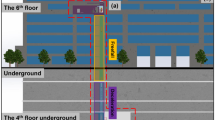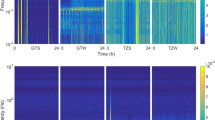Abstract
With the construction and future operation of the China Space Station (CSS), requirements of extensive preliminary ground experiments for projects onboard CSS, as well as those of scientific experiments utilizing ground-based short-term microgravity facilities, are increasing rapidly. A new microgravity experiment facility with electromagnetic launch is proposed and built by the Technology and Engineering Center for Space Utilization of Chinese Academy of Sciences. The design details of electromagnetic microgravity facility are introduced in this paper. This facility is mainly composed of double layered tower, linear induction motors, experimental capsule, energy storing device, high-power converters, electrical control system and electromagnetic release device. Then the microgravity level of the experimental payload achieved is evaluated through the analysis of kinematics and dynamics. The results of analysis indicate that the microgravity level of 10–5 g can be achieved for 4 s and optional gravity level from 10–5 g to 1 g can be created. With the drive concept, this facility will be capable of performing that the interval time between two experiments is less than 10 min. The acceleration and deceleration of experimental capsule can be controlled within 5 g through electromagnetic accelerating and electromagnetic braking. Physical verification and simulation tests are carried out on key technologies such as principle of electromagnetic launch, linear motor control, and electromagnetic release, which prove the effectiveness of the technical feasibility.


















Similar content being viewed by others
References
Bolleddula, D.A., Chen, Y.K., Semerjian, B., et al.: Compound capillary flows in complex containers: Drop tower test results. Microgravity Sci. Technol. 22(4), 475–485 (2010)
Ding, Z.L., Li J.H., Gu, Y.D., et al.: China Discipline Development Strategy, Space Science. Nation natural science foundation and Chinese Academy of Science (2016)
DeLombard, R.: Microgravity environment of ground-based facilities and non-orbital flight platforms. MEIT-2003:1–33(2003)
Gao, M., Zhao, G.H., Gu, Y.D.: Space Science and Application Mission in China’s Space Station. Bulletin of Chinese Academy of Sciences 30(6), 721–732 (2015)
Guo, B., Zhao, J.F., Li, K., Hu, W.R.: Numerical study of thermal destratification in large scale hydrogen propellant tank in space by jet injection under zero gravity condition. Chi J Theo Appl Mech 53(4), 1170–1182 (2021)
Gierse, A., Kaczmarczik, U., Greif, A., et al.: A fast and self-acting release-caging-mechanism for actively driven drop tower systems. Microgravity Sci. Technol. 29(5), 403–414 (2017)
Hu, W.R., et al.: An Introduction of microgravity sciences. Beijing: Science Press (2010)
Hu, W.R., Kang, Q.: Frontiers of microgravity science. Science and Technology Review 38(10), 59–62 (2020)
Hufenbach, B., Reiter, T., Sourgens, E.: ESA strategic planning for space exploration. Space Policy 30(3), 174–177 (2014)
Krüger, J., Richter, P., Stoltze, J., et al.: Changes of gene expression in euglena gracilis obtained during the 29th DLR parabolic flight campaign. Scientific Report 9, 14260 (2019)
Kufner, E., Blum, J., Callens, E., et al.: ESA’s Drop Tower Utilisation Activities 2000 to 2011. Microgravity Sci. Technol. 23(4), 409–425 (2011)
Koenemann, T., Kaczmarczik, U., Gierse, A., et al.: Concept for a next-generation drop tower system. Adv. Space Res. 55(6), 1728–1733 (2015)
Koide, A.: Drop-shaft type microgravity facility accommodating 10-seconds microgravity. J Japan Soc Microg. Appl. 18(3), 136–139 (2001)
Kang, Q., Duan, L., Zhang, L., Yin, Y.L., Yang, J.S., Hu, W.R.: Thermocapillary convection experiment facility of an open cylindrical annuli for SJ-10 satellite. Microgravity Sci. Technol. 28(2), 123–132 (2016)
Lu, J.Y., Tan, S., Zhang, X., et al.: Performance analysis of linear induction motor of electromagnetic catapult. 17th International Symposium on Electromagnetic Launch Technology, 2081–2087 (2014)
Lotz, C., Frobose, T., Wanner, A., et al.: A new facility for research from μg to 5g. Gravitational and Space Research 5(2), 11–27 (2017)
Lotz, C., Kamper, T., Berlin, H., Overmeyer, L.: Innovative drive and guide concept for experiments under microgravity in the Einstein-Elevator. Symposium on Automated Systems and Technologies: 1–12 (2014)
Lotz, C., Wessarges, Y., Hermsdorf, J., et al.: Novel active driven drop tower facility for microgravity experiments investigating production technologies on the example of substrate-free additive manufacturing. Advanced in Space Research 61(8), 1967–1974 (2018)
Li, Y.M., Zhang, S.C., Zhang, Y.K., et al.: A prototype of microgravity facility equipped with linear motors and design of motion plan. 70th International Astronautical Congress: 1–7 (2019)
Li, Y.M., Zhang, Y.K., Cai, Z.W., et al.: Power supply method and inductance measurement research on linear induction motor. 13th Int. Symp. Linear Drives Ind. Appl (2021)
Lotz, C., Overmayer, L.: Mechanical simulation model for verifying the feasibility of the minimal residual acceleration during the free-fall phase in the Einstein-Elevator. Fraunhofer-Institut fur Materialfluss und Logistik:1–9 (2013)
Lotz, C., Rein, M., Overmeyer, L.: Steps for a reduction of vibrations of the roller guide in the Einstein-Elevator. Symposium Automated Systems and Technologies: 87–98 (2015)
Luo, L., Zhou, H.Y., Sun, Y.H., et al.: Tsinghua University freefall facility (TUFF): a 2.2 second drop tunnel for microgravity research. Microgravity Science and Technology, 33(2): 26 (2021)
NASA: Zero gravity research facility user’s guide. Glenn Research Center (2017)
Nikhil, V.V., Abhilash, N., Niketh, P., et al.: The 2.5s microgravity drop tower at national center for combustion research and development (NCCRD), Indian Institute of Technology Madras. Microgravity Science and Technology, 30:663–673(2018)
Nie, S.X., Fu, L.J., Xu, J., et al.: Asymmetrical model and parameter calculation of segment-powered linear inductive motor mover. Electric Machines and Control 21(2), 10–17 (2017)
Nie, S.X., Ma, W.M., Li, W.C., et al.: Research on thrust ripple of long primary linear induction motors with symmetrical current excited. Proceedings of the Chinese Society for Electrical Engineering 35(21), 5585–5591 (2015)
Plenster, V., Rouquette, S., Friedrich, U., et al.: European parabolic flight campaigns with Airbus ZERO-G: Looking back at the A300 and looking forward to the A310. Adv. Space Res. 56(5), 1003–1013 (2015)
Pu, H., Dong, W.B., Zhang, Y.K., et al.: Microgravity falling tower precision three-degree-of-freedom electromagnetic release control system. J Chi Inert Tech. 28(4), 101–107 (2020)
Reitz, B., Lotz, C., Gerdes, N., et al.: Additive manufacturing under lunar gravity and microgravity. Microgravity Sci. Technol. 33(2), 25 (2021)
Takayanagi, M. and Yoda, S.I.: Status of microgravity science and ISS/JEM utilization in JAXA. 46th AIAA aerospace sciences meeting and exhibit:802 (2008)
Wei, M.G., Wan, S.S., Yao, K.Z., et al.: Research on falling tower and microgravity experiment of National Laboratory of Microgravity. Manned Spaceflight 4, 1–3 (2007)
Wollman, A., Weislogel, M.: New investigations in capillary fluidics using a drop tower. Exp. Fluids 54(4), 1499 (2013)
Wollman, A., Weislogel, M., Brently, W., et al.: More investigations in capillary fluidics using a drop tower. Exp. Fluids 57(4), 57 (2016)
Xia, C.M., Dong, W., Wang, S.M., et al.: Technique of electromagnetic hanging and releasing for micro-gravity falling tower. Spacecraft Environment Engineering 23(3), 143–145 (2006)
Yamamoto, S., Yoda, S.: Microgravity Research Projects in JAXA. 43rd AIAA aerospace science meeting and exhibit:132 (2005)
Zhao, J.F., Wang, S.F., Liu, Q., He, Z.H., Zhang, W., Li, K., Zhou, Z.B., Luo, X.H., Miao, J.Y., Zheng, H.Q., Kang, Q., Cai, W.M.: Retrospect and perspective on microgravity science in China. Chin. J. Space Sci. 41(1), 34–45 (2021)
Zhang, X.Q., Yuan, L.G., Wu, W.D., et al.: Several key technologies of the 100-meter falling tower experimental facility of the National Microgravity Laboratory. Scientia Sinica (technologic) 35(5), 523–534 (2005)
Acknowledgements
This project is supported by the Chinese Manned Space Program – Space Utilization System (412021000031), Scientific Instruments and Equipment Development Program of the Chinese Academy of Sciences (YJKYYQ20180017) and the Youth Innovation Promotion Association of CAS. We appreciated Prof. Jianfu Zhao from Institute of Mechanics, Chinese Academy of Science for offering valuable suggestion.
Author information
Authors and Affiliations
Corresponding author
Additional information
Publisher's Note
Springer Nature remains neutral with regard to jurisdictional claims in published maps and institutional affiliations.
This article belongs to the Topical Collection: Research Pioneer and Leader of Microgravity Science in China: Dedicated to the 85th Birthday of Academician Wen-Rui Hu
Guest Editors: Jian-Fu Zhao, Kai Li
Rights and permissions
About this article
Cite this article
Zhang, J., Dong, W., Wang, Z. et al. Development of a New Microgravity Experiment Facility with Electromagnetic Launch. Microgravity Sci. Technol. 33, 68 (2021). https://doi.org/10.1007/s12217-021-09915-2
Received:
Accepted:
Published:
DOI: https://doi.org/10.1007/s12217-021-09915-2




